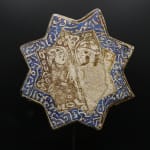Ilkhanid Lustreware Tile, depicting a Couple in Conversation, Thirteenth to Fourteenth Century AD
Terracotta, Pigment
20.5 x 20.5 x 1.1 cm
8 1/8 x 8 1/8 x 3/8 in
8 1/8 x 8 1/8 x 3/8 in
LI.3168
Further images
-
(View a larger image of thumbnail 1
)

-
(View a larger image of thumbnail 2
)

-
(View a larger image of thumbnail 3
)

-
(View a larger image of thumbnail 4
)

-
(View a larger image of thumbnail 5
)

-
(View a larger image of thumbnail 6
)

-
(View a larger image of thumbnail 7
)

-
(View a larger image of thumbnail 8
)

Within the canon of Islamic fine art, tiles often bear significance in reproducing the quotidian, landscapes and societal beliefs. Irrespective of their insulative properties, tiles evolved from their functional form,...
Within the canon of Islamic fine art, tiles often bear significance in reproducing the quotidian, landscapes and societal beliefs. Irrespective of their insulative properties, tiles evolved from their functional form, to a unique facet of early to middle Islamic art. With the rise in popularity of lusterware, the city of Kashan in modern day Iran became the epicentre of production. Lusterware tiles were used to decorate the facades of homes, for protection from evil eye (nazar) through Quranic verses such as Ayat al Kursi or as a display of wealth.
This particular tile is a testimony to the artistry and opulent flare the Ilkhanid period experienced. This eight-pointed star shaped tile holds inscriptions that contain verses of Persian poetry decorated with the image of two lovers. The production of such tiles in luster was a complicated technique in which opaque white, blue and turquoise glazes were applied to the ceramic body for the first firing and a copper luster was applied for a second firing.
The Ilkhanids (1256-1335 CE) were a Mongol dynasty that ruled over present-day Iran, most of Iraq, Afghanistan, Turkmenistan, Armenia, Azerbaijan, Georgia, Turkey, and western Pakistan.
This particular tile is a testimony to the artistry and opulent flare the Ilkhanid period experienced. This eight-pointed star shaped tile holds inscriptions that contain verses of Persian poetry decorated with the image of two lovers. The production of such tiles in luster was a complicated technique in which opaque white, blue and turquoise glazes were applied to the ceramic body for the first firing and a copper luster was applied for a second firing.
The Ilkhanids (1256-1335 CE) were a Mongol dynasty that ruled over present-day Iran, most of Iraq, Afghanistan, Turkmenistan, Armenia, Azerbaijan, Georgia, Turkey, and western Pakistan.







